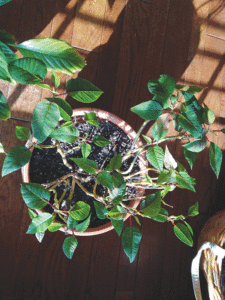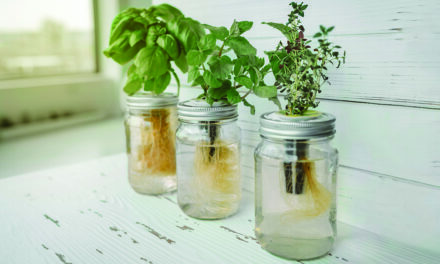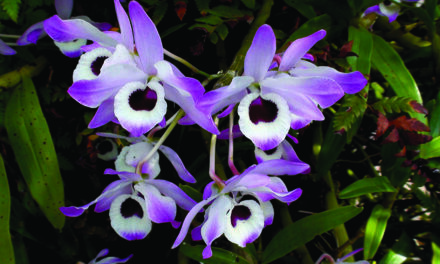
Possessing neither secret potion nor magic formula, Shirley Edwards also doesn’t shroud the plants in a dark closet, the supposed method attributed to popular lore. Instead, she abides by a 25-year-old magazine article. (Photo courtesy Shirley Edwards)
By Debra R. Messick
Like many people, I once believed poinsettias were preordained to last only as long the Christmas season.
A few hardy specimens might linger briefly into the new year, but once the holidays were gone, so too were the iconic flowers identified with them.
Thanks to two patrons of Hurlock Library in northern Dorchester County, I learned that a little luck and a lot of care can keep poinsettias thriving far beyond one brief annual interlude.
Just prior to Christmas 2016, a frequent library visitor was suddenly gifted an enormous poinsettia.
Concerned for the safety of her feline friends at home (the plant can be toxic if ingested by cats) she donated the supersized specimen to Hurlock’s library branch, brightening the lobby through December and well into January.
Staff and visitors were resigned to the eventual day it would wilt away, but that day never came. On Valentine’s Day, the plant remained hardy.
As the Spring Equinox arrived, though its size had gradually diminished, its overall vigor remained intact. With Easter rapidly approaching, staff began fielding questions about what the poinsettia was still doing there.
As murmurs began about the possibility of decorating the “overdue” poinsettia’s pot with bunnies and eggs, another patron mercifully stepped in with a solution.
While checking out a book early last spring, Shirley Edwards was taken with the plant’s fortitude, and mentioned that she might be able to take it home and look after it, just as she’s cared for five other poinsettias, which have continued to grow year round and bloom each Christmas season.
Possessing neither secret potion nor magic formula, she also doesn’t shroud the plants in a dark closet, the supposed method attributed to popular lore.
Instead, Edwards abides by the advice of writer Rena Presley, whose 1992 magazine posting entitled “The Perennial Christmas Poinsettia,” was sent to her via her sister-in-law.
Presley’s professional credentials are unknown, but she possessed two poinsettias “going strong” after 18 years, which seems to lend unerring credence to her formula for success:
• Place poinsettias near a sunny window; water once or twice a week to maintain the bloom until May, (bloom refers to “bracts”, resembling leaves in red, white, or pink, “growing beneath and surrounding the flower cluster.”);
• In May, move the plant outdoors to a spot with “plenty of sunlight” but also protected when temperatures soar;
• In June, trim plant down to two to three inches above the soil; continue to water regularly. New growth should appear in two to three weeks;
• About two months later, prune two to three inches from the plant’s top to promote bract production;
• Before cold weather sets in, return poinsettias to the house in warm (but not too warm!) sunlit room; and
• Provide “a bit” of all purpose houseplant fertilizer, sparingly, when watering. (Too much fertilizer may result in height instead of fullness.) Repot, particularly if poinsettia remains in its original container, add stones or gravel to new pot bottom for good drainage, use “good” potting soil.
The result, according to Presley: by Thanksgiving, new bracts should be “peeping through,” and by Christmas, festive crimson flowers once again crowning the green foliage.
Following these guidelines, which she’s kept as a handy reference, has helped Edwards to maintain at least six poinsettias, including a tiny one gifted to her mother at a party years ago, the library poinsettia rescued last spring, and one now enclosed in a heavy glass terrarium.
She offers helpful hints from her own experience:
• A south-facing window is a good choice for the right amount of sunlight;
• Under a light fixture by day, the plant will receive enough ‘dark time’ to balance out and keep it from growing too rampantly;
• Maintain a temperature neither too cold or too warm inside or outside;
• Especially when outside in the warmer months, it’s best to provide morning sun and afternoon shade;
• Rainwater, if fairly regular, is usually sufficient; in extremely hot, dry weather, hand water; and
• Don’t overwater or leave sitting in water — it will get soggy and rot!
Edwards added that she usually repots before taking them outside, and before bringing them in.
She’s also careful to use a minimum of fertilizer, and surmises some growers may combine several plants in a single pot to compensate for the overly tall and less full over fertilization results (pruning revealed that the library Poinsettia was, indeed, three plants in one container).
Though her efforts have overall been successful, they can fall short at times, she cautioned.
This year’s challenge arrived when one Poinsettia lost all its leaves outdoors, leaving a meager remnant of its former glory.
“Bill (Edwards’ husband) said ‘what do you want to do with this one’ and I said ‘I think I would like to try and bring it back. So we repotted it. I’m watching it and hoping I can see a little bud somewhere. It looks just like a dead branch, but it has some green on it, so that made me think well hey, these roots are good, I can do something with it.” With a laugh she added, “It’s gotta not just look dead, but be dead ‘d-e-a-d’ before I throw it away.”
Asked about her the roots of her desire to help poinsettias persevere, Edwards wasn’t sure of the answer.
“I guess it’s just the way I feel. A lot of people say it’s too much trouble to go to for something that lasts for a short period of time,” she said. “But I just like poinsettias. I always thought they were such a beautiful Christmas flower.”
Though not part of her home holiday celebrations, Edwards’ church’s alter has always been adorned with them at Christmastime.
While roses are traditionally the favorite flower for many, to her poinsettias are lovely in a different way, representing the time of year when family comes together to celebrate. Just as planning those moments takes time, and effort, and care, the love and memories planted last well past the brief season, she said.






